Most U.S. religious attenders – that is, Americans who said last year that they typically go to religious services at least once or twice a month, plus those who report having gone in person in the past month – said their congregation was open and holding religious services at the time the survey was conducted in mid-July. This includes 55% who say their congregation is open with certain coronavirus-related modifications in place and 6% who say their congregation is open and operating normally, just as it did before the outbreak began. Many houses of worship appear to have opened since April, when 91% of people who said in a 2019 survey that they attend religious services regularly indicated that their congregations were closed entirely.
A majority of attenders also say they feel at least somewhat confident that they could safely attend religious services at their congregation without contracting or spreading the coronavirus. Still, just one-third of respondents who typically attend religious services at least once a month say they have done so in the past month. Far higher numbers say they have watched religious services online or on television.
Looking ahead, however, most people indicate they plan to resume their pre-pandemic religious attendance routines once the outbreak is over. The remainder of this chapter explores Americans’ religious behaviors amid the pandemic in more depth, including congregants’ opinions about the precautions being taken.
How many Americans are attending religious services in person or online?
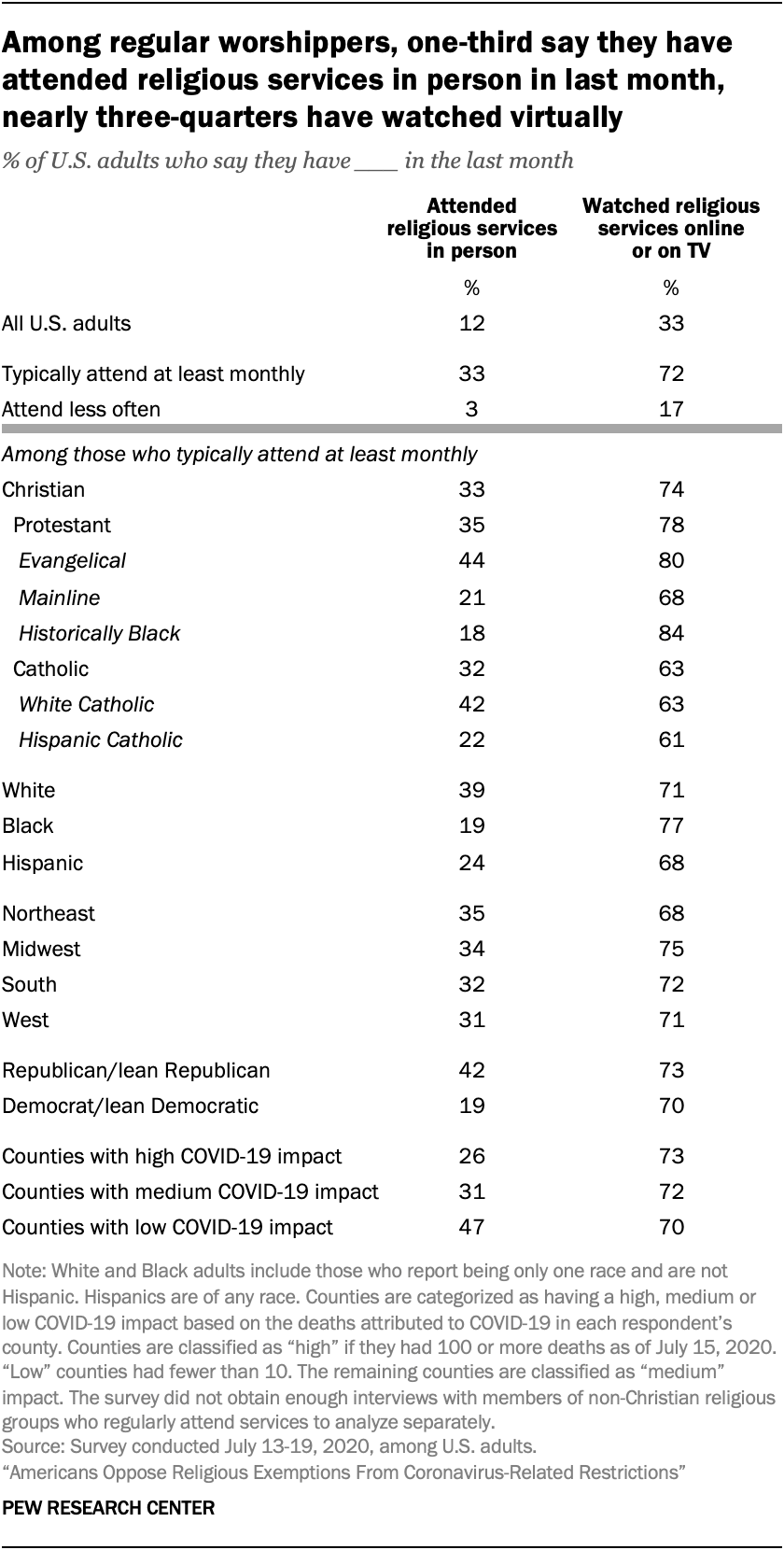
Roughly one-in-eight U.S. adults (12%) say they attended religious services in person during the last month, and one-in-three say they have watched religious services online or on television. Participation in both activities is most common among those who said prior to the outbreak (as part of a 2019 survey) that they attend religious services at least once a month.
Among those who typically attend religious services at least monthly, one-third say they have done so in person during the last month, and nearly three-quarters (72%) say they have watched religious services online or on TV. Among those who said (prior to the onset of the pandemic) that they do not regularly attend religious services, just 3% say they have attended worship services during the past month and 17% say they have watched virtually.
Evangelical Protestants report having attended in-person religious services during the last month at higher rates than members of other Christian traditions. And white Americans who typically attend worship services have recently gone in person at higher rates than Black and Hispanic attenders. For example, among Catholic Mass-goers, whites are almost twice as likely as Hispanics (42% vs. 22%) to say they have attended in-person Mass recently.
Overall, Black and Hispanic Americans who typically attend religious services on at least a monthly basis are no less likely than their white counterparts to say they have recently watched religious services online or on TV.
The survey finds only modest differences across regions of the country on these questions. However, people living in counties where the outbreak has had a smaller impact (that is, counties in which fewer than 10 people have died of the virus) are about twice as likely as those living in high-impact counties (counties with 100 or more coronavirus deaths) to say they have attended in-person religious services in the past month (47% vs. 26%).
Among attenders, Republicans and those who lean toward the Republican Party are much more likely than Democrats to say they have recently gone in person to a religious service (42% vs. 19%), but there is no difference between the two parties in the share who say they have recently watched religious services online or on television.
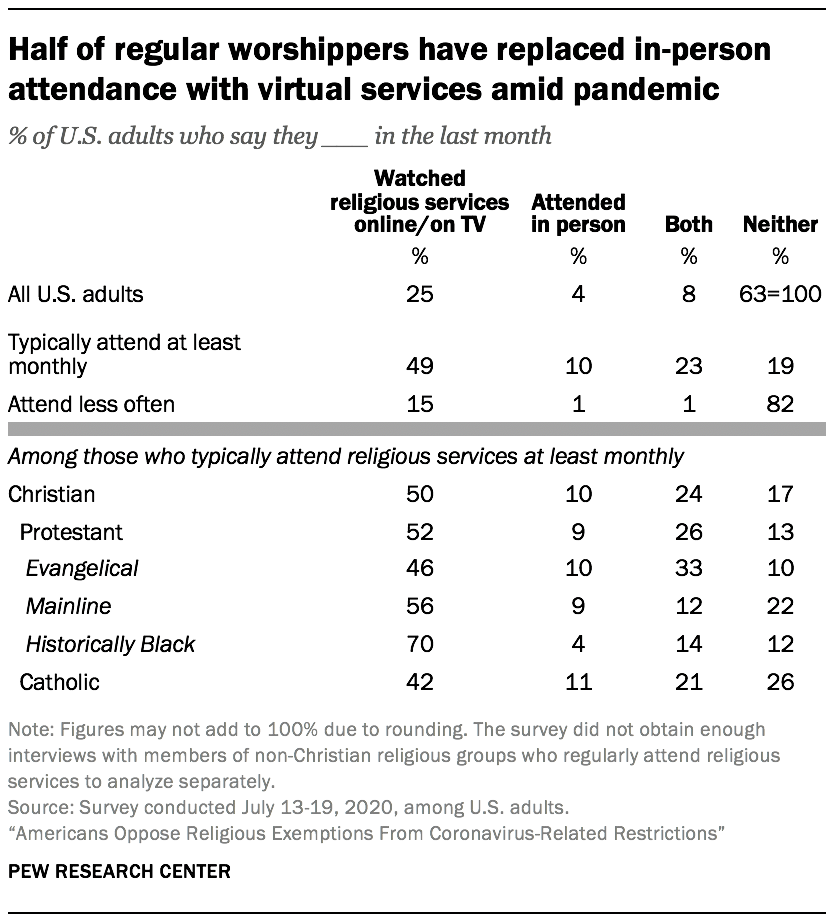
These two questions (about in-person religious attendance and viewership of virtual services) can be combined to provide a rough sense of how many Americans have replaced in-person religious attendance with virtual attendance, at least temporarily. Overall, about half of U.S. adults who typically attended religious services at least once a month in 2019 (49%) appear to have substituted virtual participation for in-person attendance: They have recently watched services online or on television and have not attended in person.
Roughly a quarter of regular worship attenders (23%) appear to be supplementing in-person attendance with virtual participation: They have both attended religious services and watched them online or on TV in the last month. Just one-in-ten regular worship attenders say they are still attending services in person and have not recently watched services virtually, while one-in-five (19%) have neither attended in person nor watched religious services online in recent weeks.
Evangelical Protestant churchgoers are more likely than other Christians to say they have both attended church services and watched them online or on TV in the past month. Churchgoers in the historically Black Protestant tradition, meanwhile, are more likely than others to say they have recently watched religious services online or on TV instead of attending in person. Roughly one-quarter of churchgoing Catholics (26%) and mainline Protestants (22%) say they have neither attended nor watched church services in recent weeks.
Many Americans experiencing virtual services for the first time, experimenting with different congregations
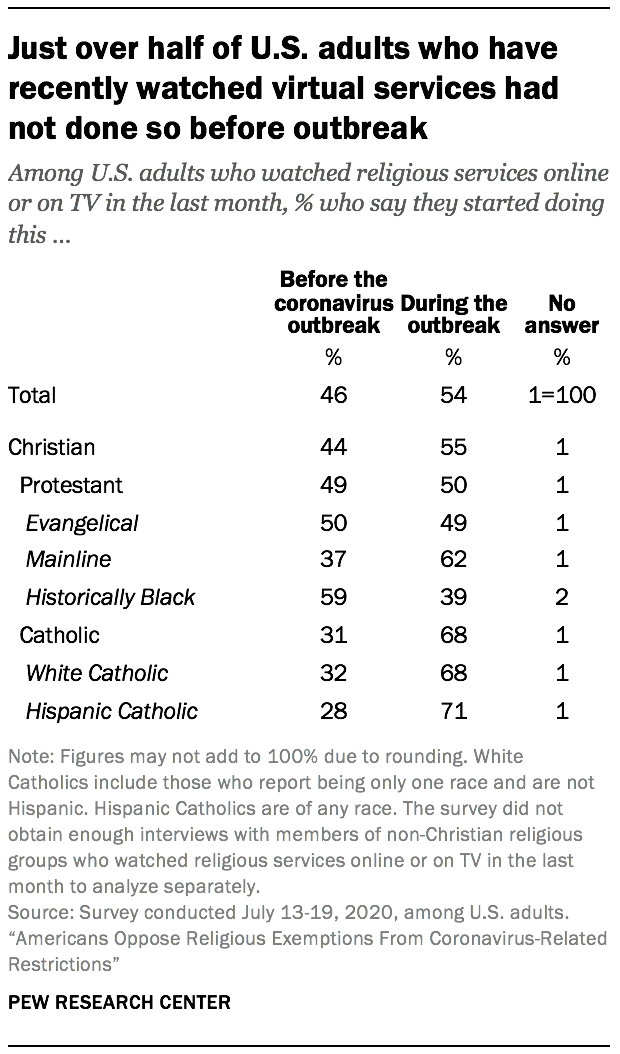
Slightly more than half of U.S. adults who have watched religious services online or on TV in the last month say that this is something they started doing during the coronavirus outbreak (54%), while 46% say they watched virtual services even before the onset of the pandemic.
Among those who have recently watched religious services online or on TV, majorities of Catholics (68%) and mainline Protestants (62%) say watching virtual church services has been a new experience for them as a result of the outbreak, while most people in the historically Black Protestant tradition (59%) and half of evangelical Protestants say they had done this before.
With a wide variety of virtual services available to anyone with an internet connection, many Americans appear to be taking advantage of them and are trying something new.
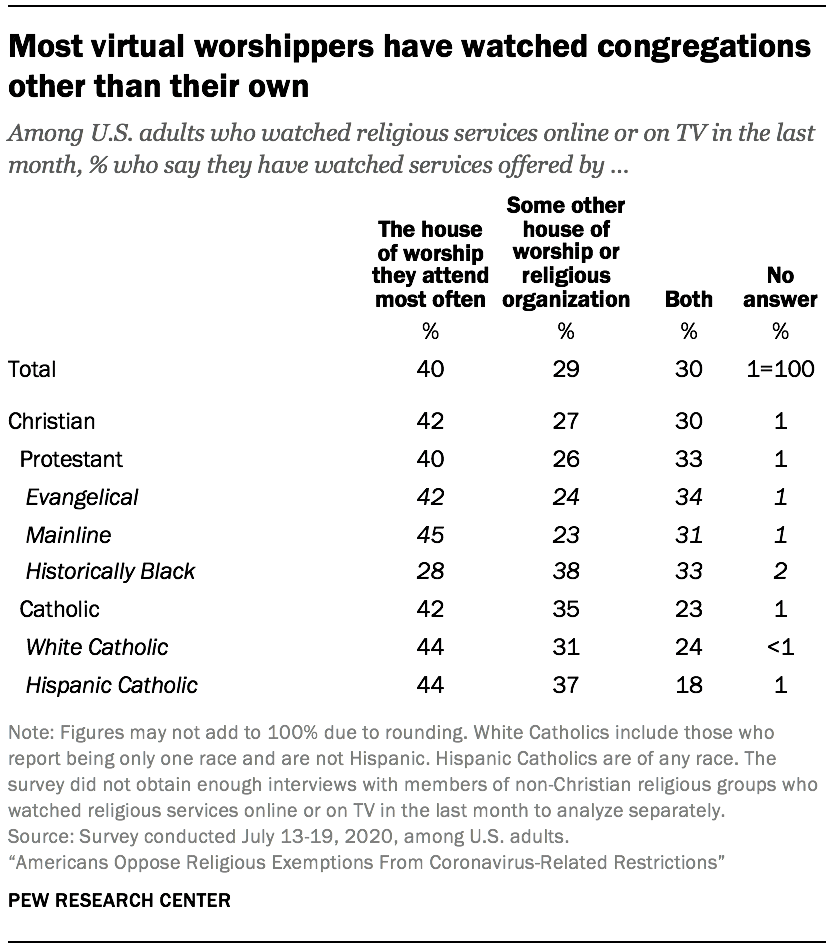
Fewer than half of those who have watched religious services online or on TV in the past month (40%) say they have watched services offered only by the congregation that they typically attend, while three-in-ten (30%) say they have watched services both from their own congregation and from others. An additional three-in-ten (29%) say they have exclusively watched services offered by congregations or religious organizations other than the one they typically attend.
There are few differences across most Christian groups on this question, although members of the historically Black Protestant tradition are less likely than others to exclusively watch their own congregation.
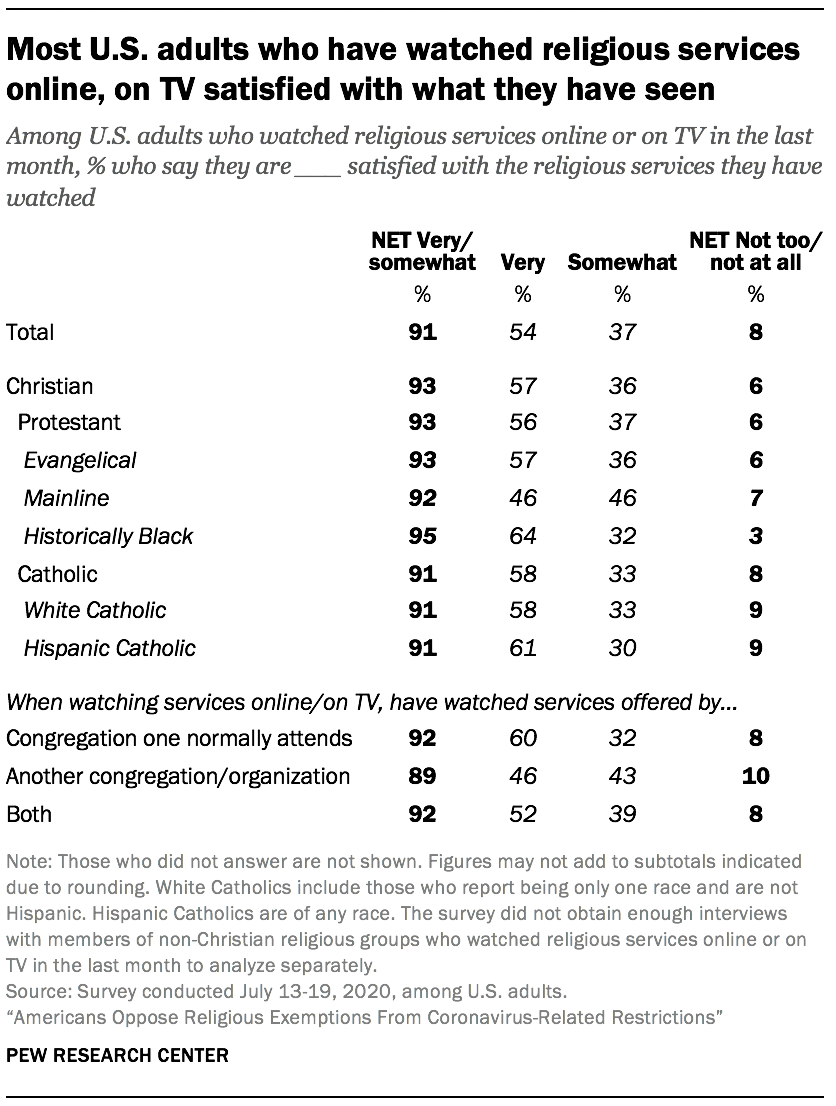
Overall, nine-in-ten U.S. adults who have recently watched religious services online say they have been satisfied with what they have seen, including 54% who have been “very” satisfied and 37% who have been “somewhat” satisfied.
Though upward of nine-in-ten Christians are at least somewhat satisfied with the religious services they have watched, mainline Protestants are somewhat less likely to be “very” satisfied (46%) than other Christian groups. And those who say they have watched religious services offered only by their own house of worship are somewhat more apt to say they have been very satisfied (60%) than those who have watched services offered by some other congregation (46%) or those who have watched both (52%).
Most say donations to houses of worship have not changed, although more have decreased than increased
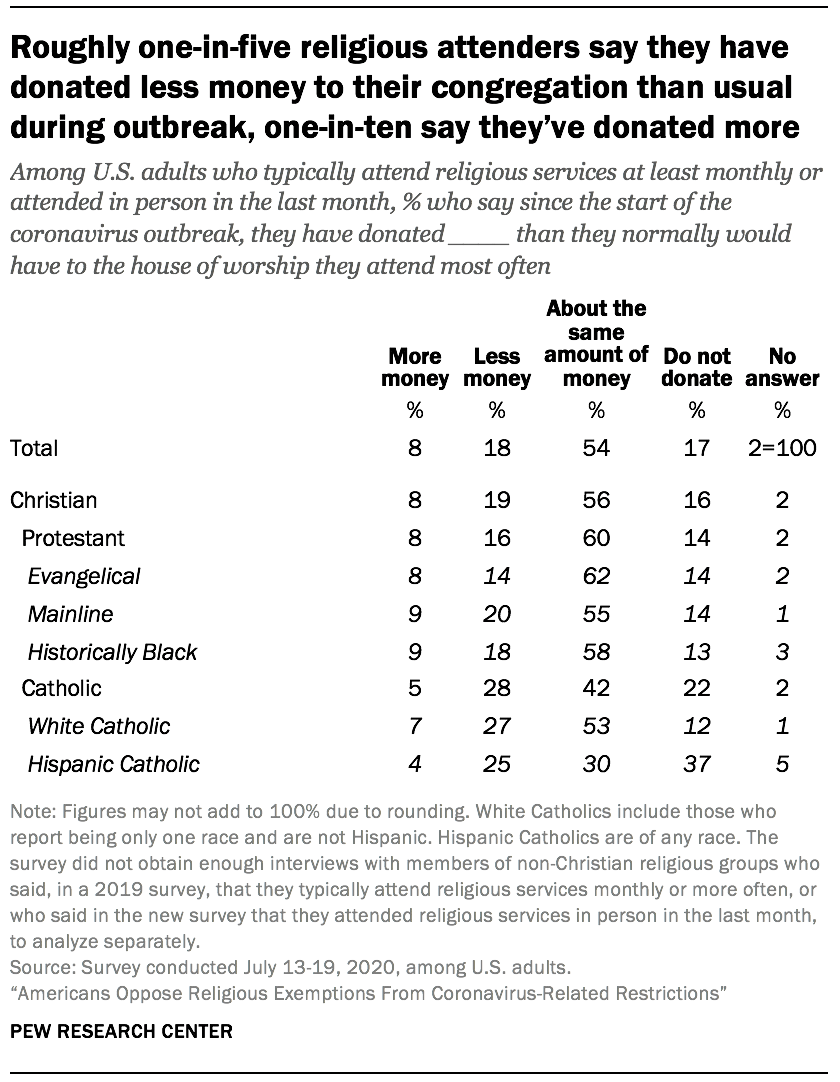
As many people have become physically distanced from their religious congregation, how is this affecting houses of worship financially?
About seven-in-ten U.S. religious attenders indicate that the donations they make to their congregation have not changed much since the start of the coronavirus outbreak, including 54% who say they have donated about the same amount of money as they normally would have and 17% who say that they do not make financial donations to their congregation.
Nearly one-in-five (18%) say they have donated less money to their congregation since the start of the pandemic, which is nearly twice the number who say they have donated more than they normally would have (8%). The disparity between those who have increased and decreased their donations is most pronounced among Catholics, 28% of whom have donated less than they otherwise would have, compared with 5% who have donated more.
Most say their religious attendance habits will revert to pre-pandemic norms
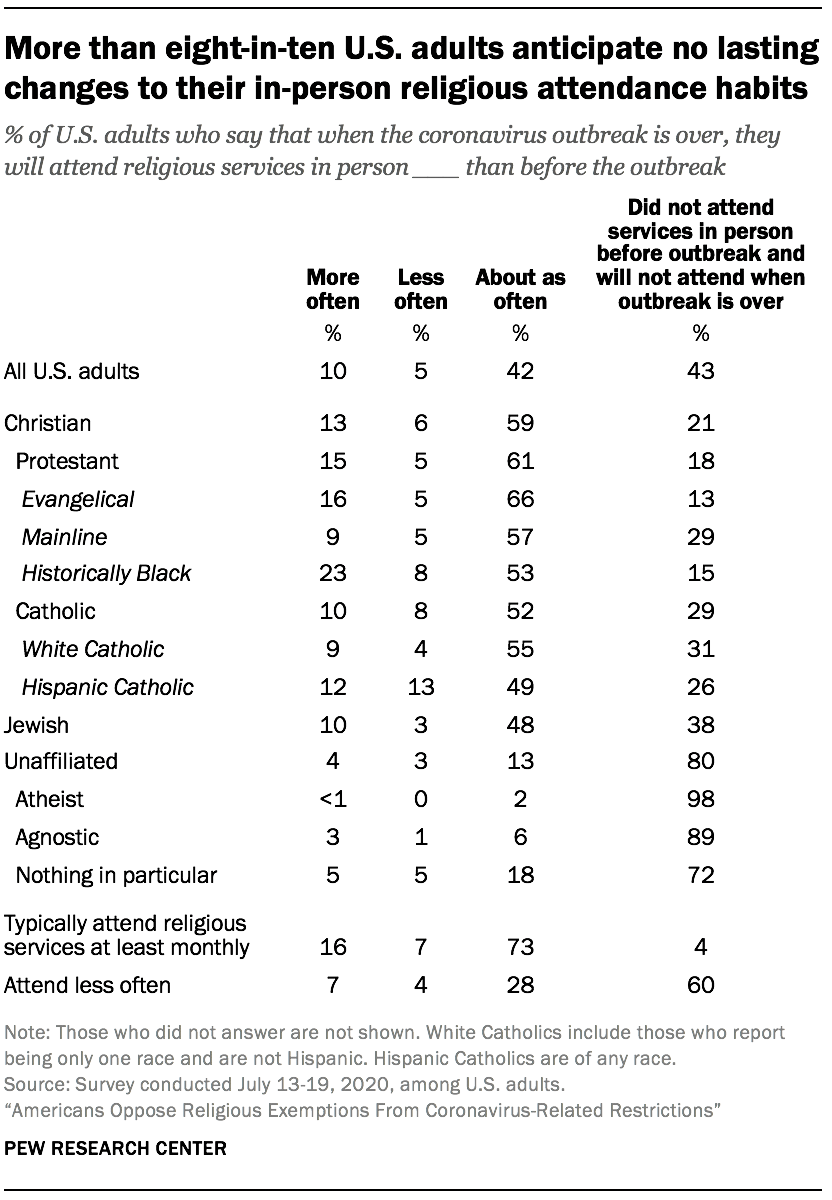
While some have wondered whether the pandemic will permanently change the way people practice religion, most U.S. adults say that once the coronavirus outbreak is over, their religious attendance habits will revert to what they were before. This includes 42% who say they will attend in-person religious services about as often as they did before the outbreak, and an additional 43% who say they did not attend religious services before the outbreak and will not do so once it is over.
Among those who expect their religious attendance habits to change, a greater number say they anticipate going in person more often than they did before (10% of all U.S. adults), rather than less often (5%).
Both respondents who reported attending religious services regularly before the pandemic (as part of a 2019 survey) and respondents who were not regular attenders mostly project a return or continuation of their normal habits following the crisis. But people who say they attended religious services at least monthly before the pandemic are more likely than those who attended less often to say they anticipate increasing their attendance once the crisis has passed (16% vs. 7%).
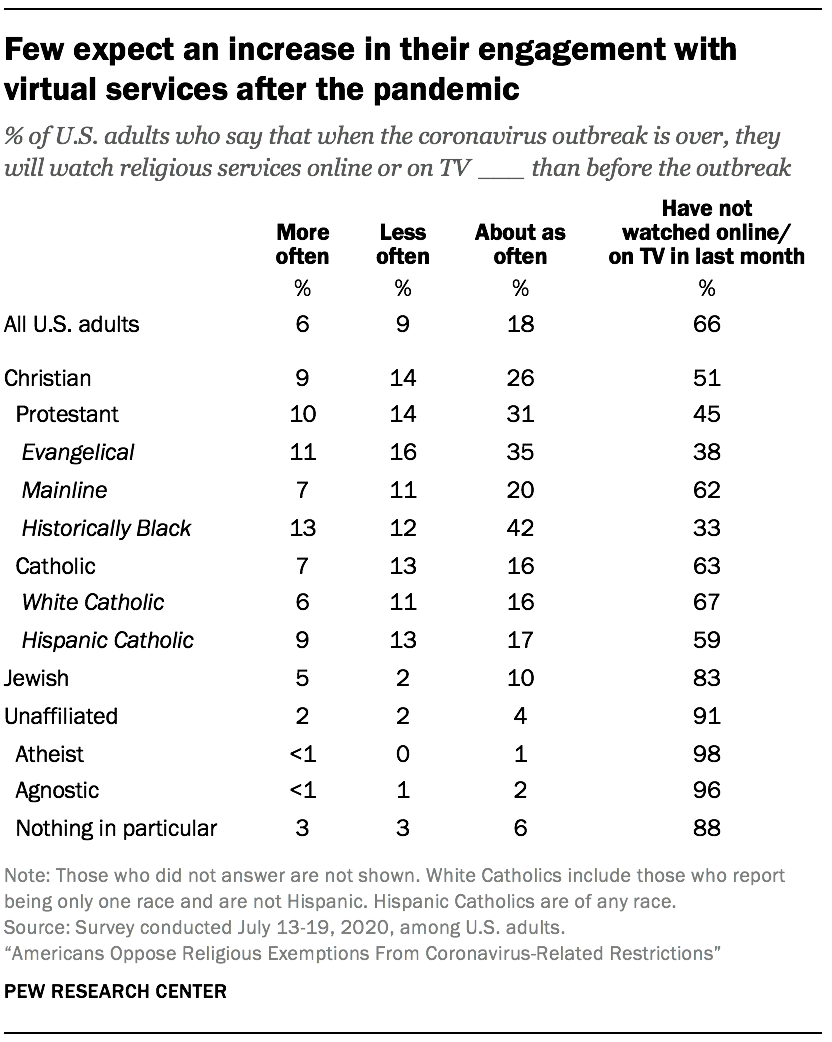
Just as most people foresee returning to pre-pandemic rates of in-person attendance once the coronavirus outbreak is over, the survey finds little evidence to predict a large-scale increase in engagement with virtual services.
Overall, 6% of U.S. adults say they anticipate watching religious services online or on TV more often after the pandemic than they did before the pandemic, while 9% say they will watch religious services less often. Nearly one-in-five (18%) envision no change, and 66% were not asked this question because they did not report watching religious services in the last month.
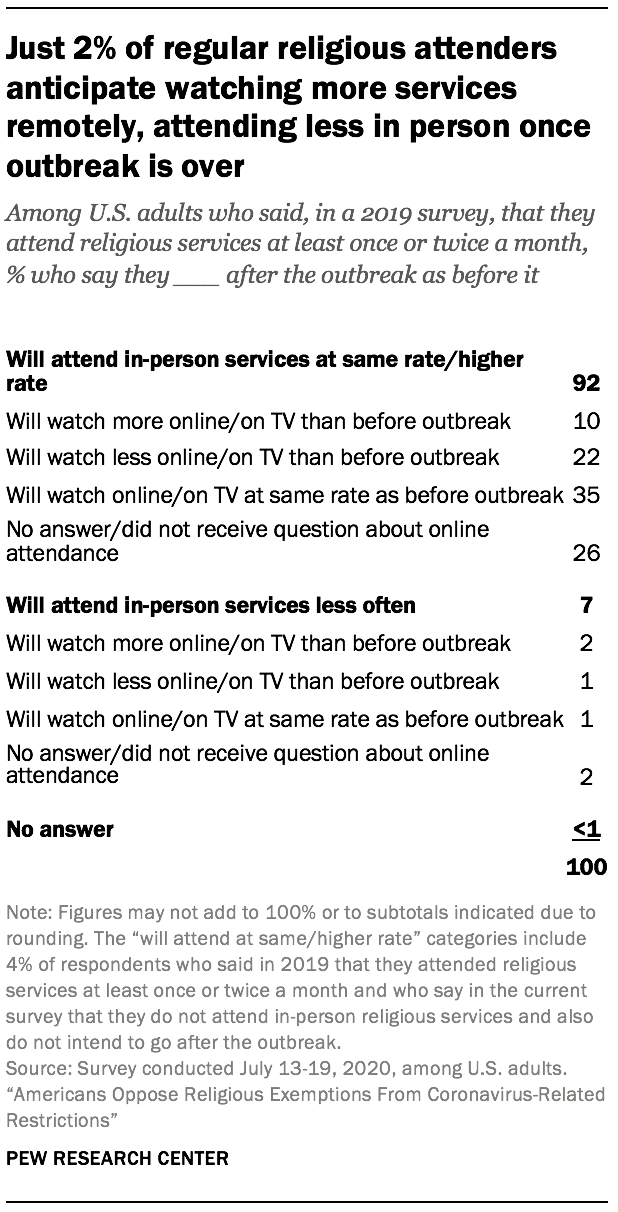
Combining these two questions – about whether respondents anticipate changes to their in-person or virtual religious behavior after the pandemic, compared with before – can shed light on a discussion observers of American religion have raised about the long-term impact of the pandemic on U.S. religious life.
Will the pandemic leave regular religious attenders wary of large gatherings and less likely to attend in-person religious services? Will people appreciate the convenience and safety of “virtual” attendance and seek to continue practicing that way? Or will Americans miss the social connections associated with a religious congregation? Furthermore, could the crisis brought on by the pandemic lead to a revival of religious interest and observance among those who did not regularly attend religious services before the pandemic? Or will the forced separation from religious communities hasten the rise of the religious “nones” in America?
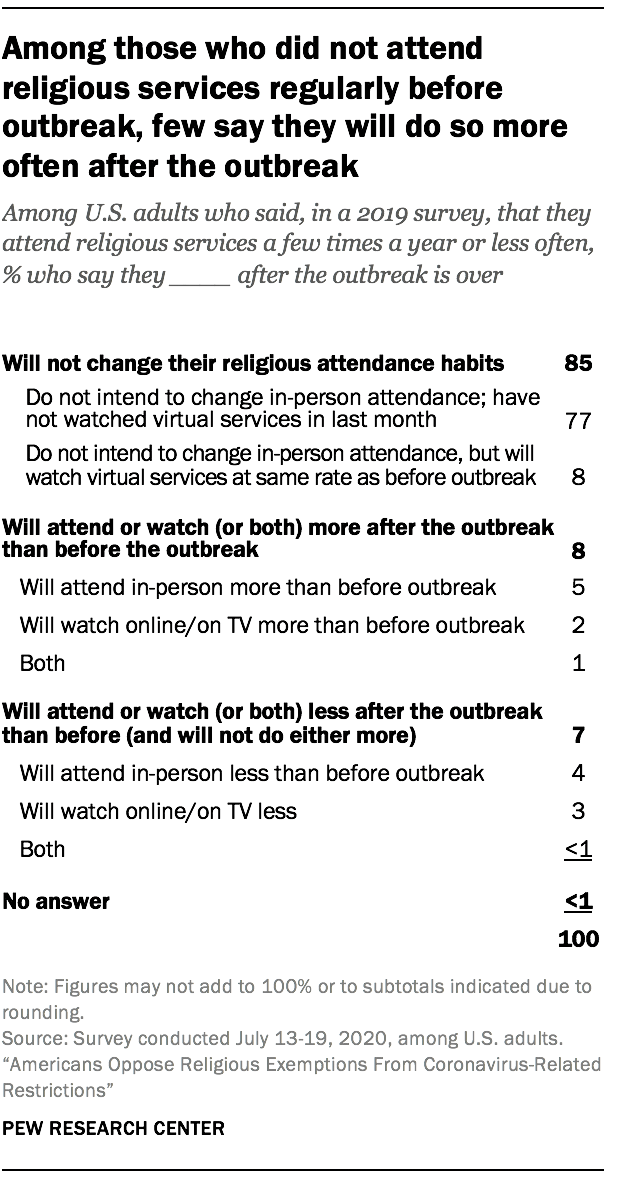
While the outbreak is not over, the survey suggests that the pandemic will not produce widespread, lasting changes in patterns of attendance at religious services. More than nine-in-ten people who were regular religious attenders before the outbreak (92%) say they intend to resume their previous level of religious attendance or plan to attend religious services even more often once the outbreak is over. And within this group, most say they will watch virtual services either at the same rate or less often than they did before the outbreak.
Meanwhile, just 2% of regular religious attenders indicate that they may substitute online or televised religious services for in-person attendance (by saying both that they intend to go to in-person religious services less often than they did before the pandemic and that they plan to watch virtual services more often).
Nor is there much evidence of a renewed desire to attend or watch religious services among those who did not regularly do so before the pandemic. Among those who reported in a 2019 survey that they typically attend religious services a few times a year or less often, 85% foresee no change to their religious attendance or viewing habits after the pandemic has passed, while 8% indicate they will either attend or watch religious services more often and 7% say they will attend or watch less often than they did to begin with.
What people think about modifications to in-person religious attendance, and what their house of worship is doing
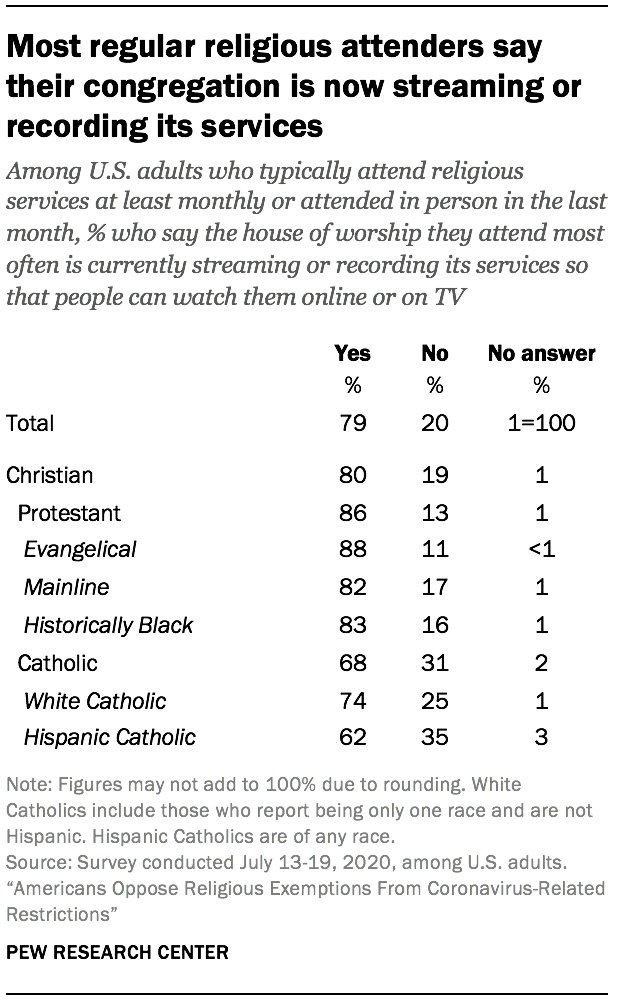
Among those who said in a 2019 survey that they attend religious services at least monthly or who say in the current survey that they attended in the last month, eight-in-ten say their congregation is now streaming or recording its services so that they can be viewed online or on TV. Protestants are more likely than Catholics to say this about their congregation. Still, two-thirds of Catholics say their parish now provides this kind of electronic outreach.
More broadly, the survey finds that few U.S. adults who typically attend religious services (6%) say their congregations are open and operating normally, just as they were before the onset of the pandemic. Among religious attenders, 31% say their congregation is closed altogether, while 55% say their house of worship is open and holding religious services, but with modifications as a result of the outbreak.
Among four possible modifications mentioned in the survey, the most common one that congregants encounter is mandatory social distancing: 45% of religious attenders say congregants at their house of worship are required to stay at least 6 feet apart from each other during services. (When limiting the analysis to people who say that their house of worship is open with modifications, 82% say their house of worship requires people to stay at least 6 feet apart.)
Another 36% of attenders say there are restrictions on the number of people who can gather at any one time in their congregation, and 35% say those attending religious services are required to wear masks (in both cases, upward of six-in-ten attenders whose congregations are open but modified say this). Fewer say their congregation has limited or prohibited communal singing (20% of all religious attenders, 37% of all those at open-but-modified congregations).
Mainline Protestants and those in the historically Black Protestant tradition are more likely than those in other Christian groups to say their congregation is currently closed. Evangelical Protestants and Catholics, by contrast, are more likely than other Christians to say that their churches are open in a modified way. Few people in any Christian tradition say their congregations are operating normally.
Four-in-ten religious attenders who reside in the West and 33% of those who live in the South say their congregation is now closed, which is higher than the shares who say this in the Midwest and Northeast (24% each). And those who live in parts of the country where the virus has hit hardest (in terms of death toll) are more likely than those who live in the least severely affected areas to say their places of worship are closed entirely. But across the country, from the Northeast to the West and from the hardest-hit areas to the least affected, fewer than one-in-ten attenders say their congregations are open and functioning normally.
Among religious attenders, Democrats and those who lean toward the Democratic Party are more likely than Republicans and Republican leaners to say their congregation is closed, while Republicans are more likely than Democrats to say their congregation is open in a modified way.
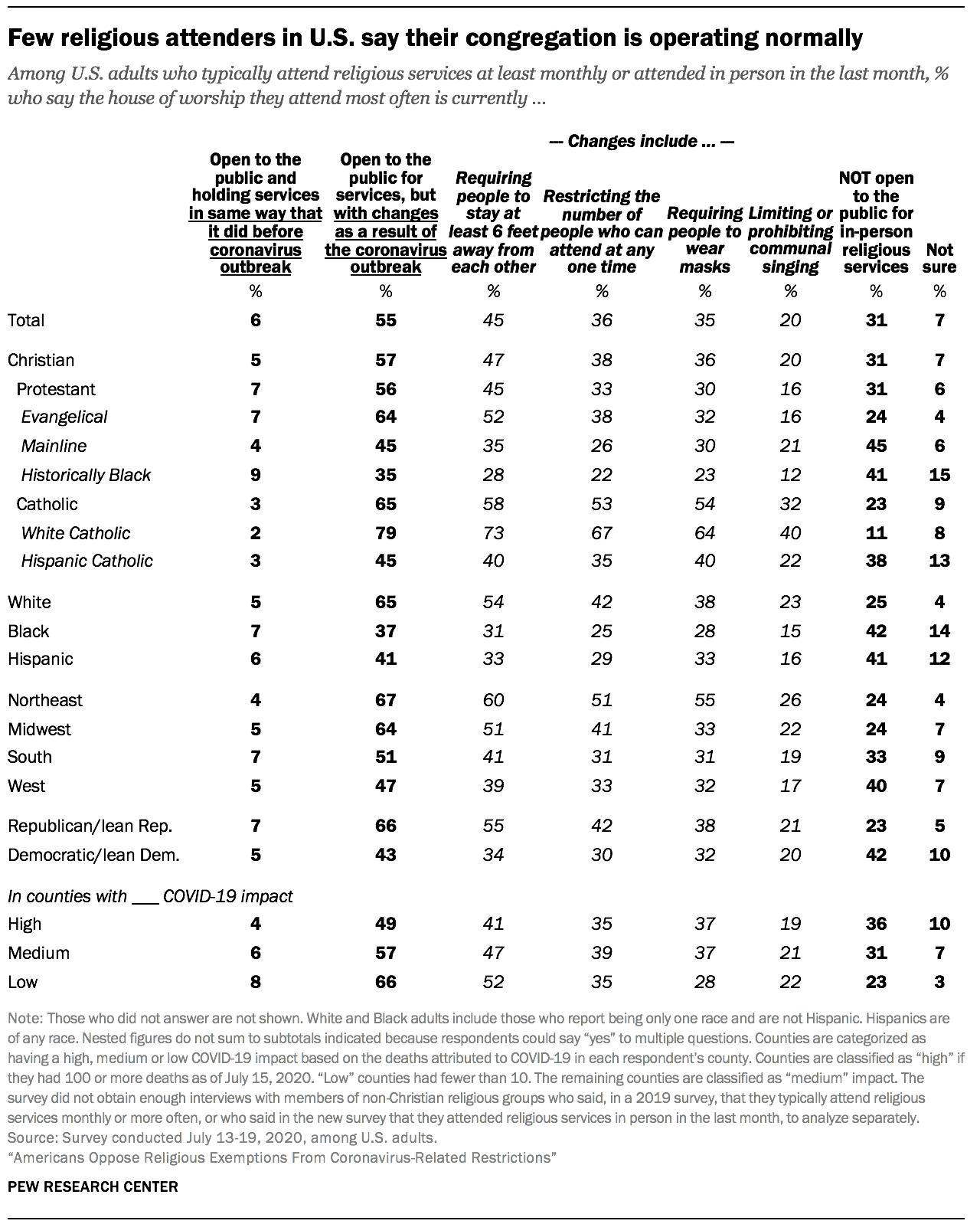
U.S. congregants generally are on board with implementing restrictions at their congregations. Nearly three-in-ten religious attenders (those who said in a 2019 survey that they attend services at least monthly or those who say in the current survey that they attended in person in the last month) say they think their congregation should be fully closed, and 57% think their congregation should be operating on a modified basis. Far fewer people think their congregations should be open and operating as normal. However, there are about twice as many religious attenders who think their congregation should be operating normally (13%) as there are who say their congregation currently is operating normally (6%).
Mainline Protestants, members of the historically Black Protestant tradition and Hispanic Catholics are more likely than other Christian subgroups to say their congregation should be closed. White Catholics are more likely than other Christian groups to say their parishes should be open and holding services, but with various modifications in place. And evangelical Protestants are more inclined than any other group to say their congregation should be open and operating normally, although this is a minority opinion even among evangelicals (18%).
Roughly four-in-ten Black (42%) and Hispanic (37%) religious attenders think their congregations should currently be closed. By comparison, just 21% of white attenders say the same. White respondents are more likely than Black and Hispanic religious attenders to say their congregations should be open on a modified basis.
Democrats who regularly attend religious services (54% of whom are Black or Hispanic) are more than twice as likely as Republican attenders (who are mostly white) to say their congregation should be closed (44% vs. 16%). By contrast, Republicans are more likely than Democrats to say their congregations should be open and operating normally (19% vs. 6%). A larger share of Republicans than Democrats also say their congregations should be open with modifications (64% vs. 48%).
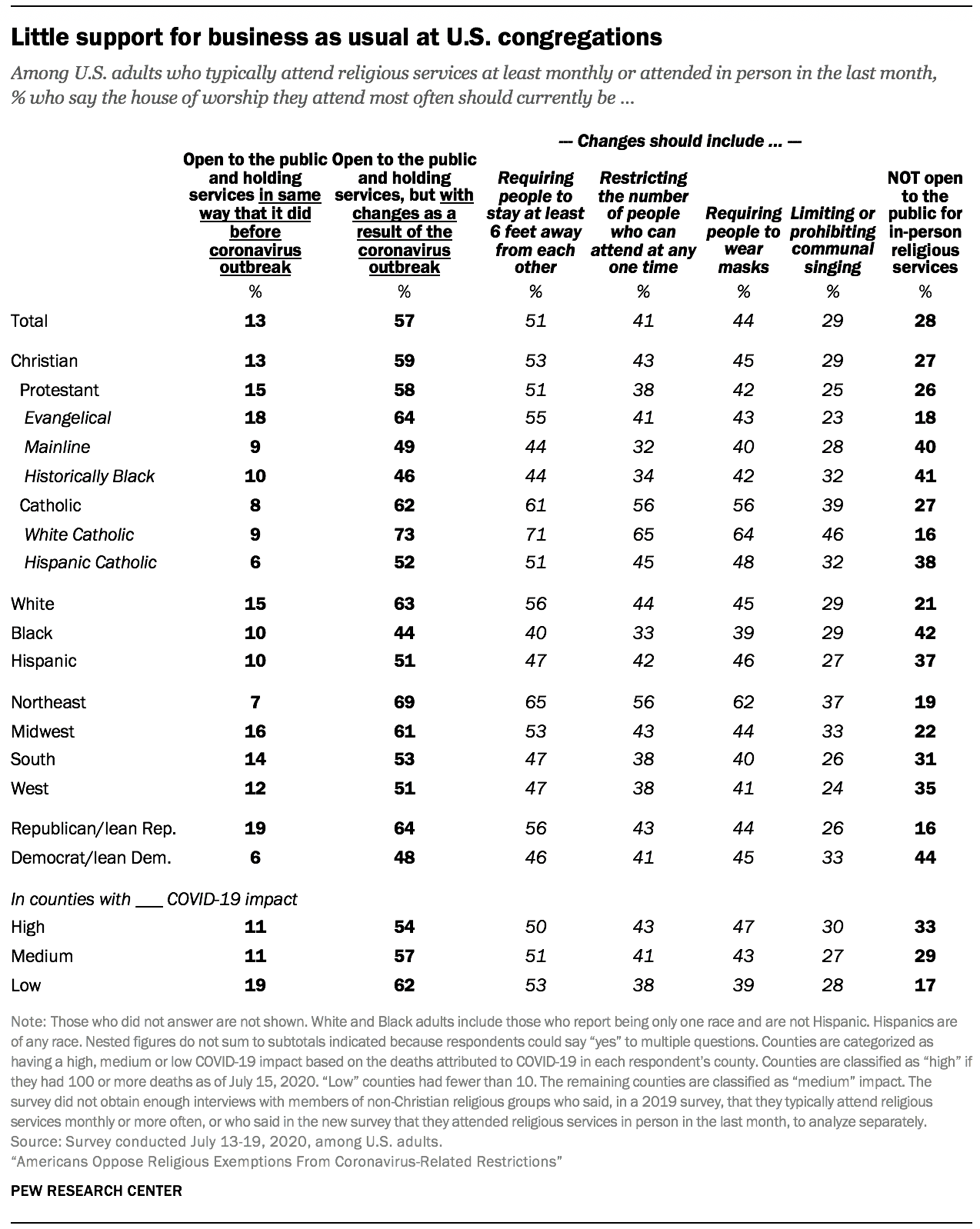
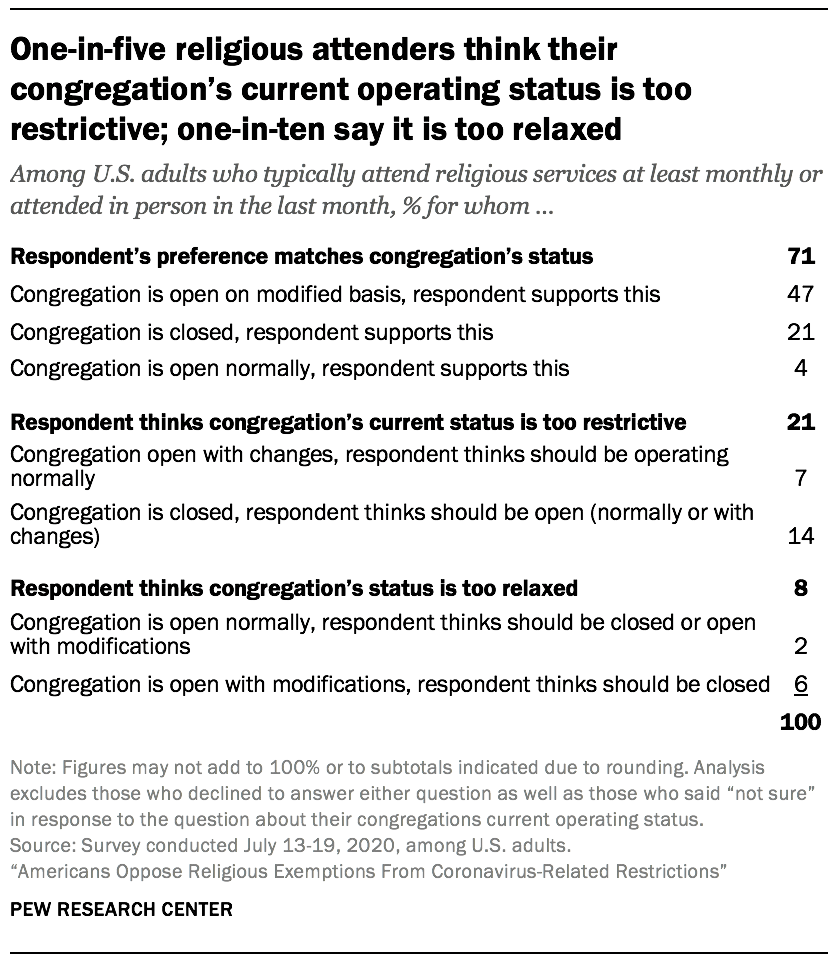
Taken together, these questions show that seven-in-ten U.S. religious attenders have preferences that align with the current operating status of their congregation, including 47% who attend congregations that are open with modifications and say that is the proper approach. An additional 21% attend congregations that are fully closed and say they should be, and 4% attend congregations that are operating normally and think this is the right call.
One-in-five religious attenders think their congregation’s current status is too restrictive (for example, their congregation is closed and they think it should be open in some way), while fewer (8%) think their congregation’s current operating status is too lax.
Most attenders say they are confident they could worship without catching virus
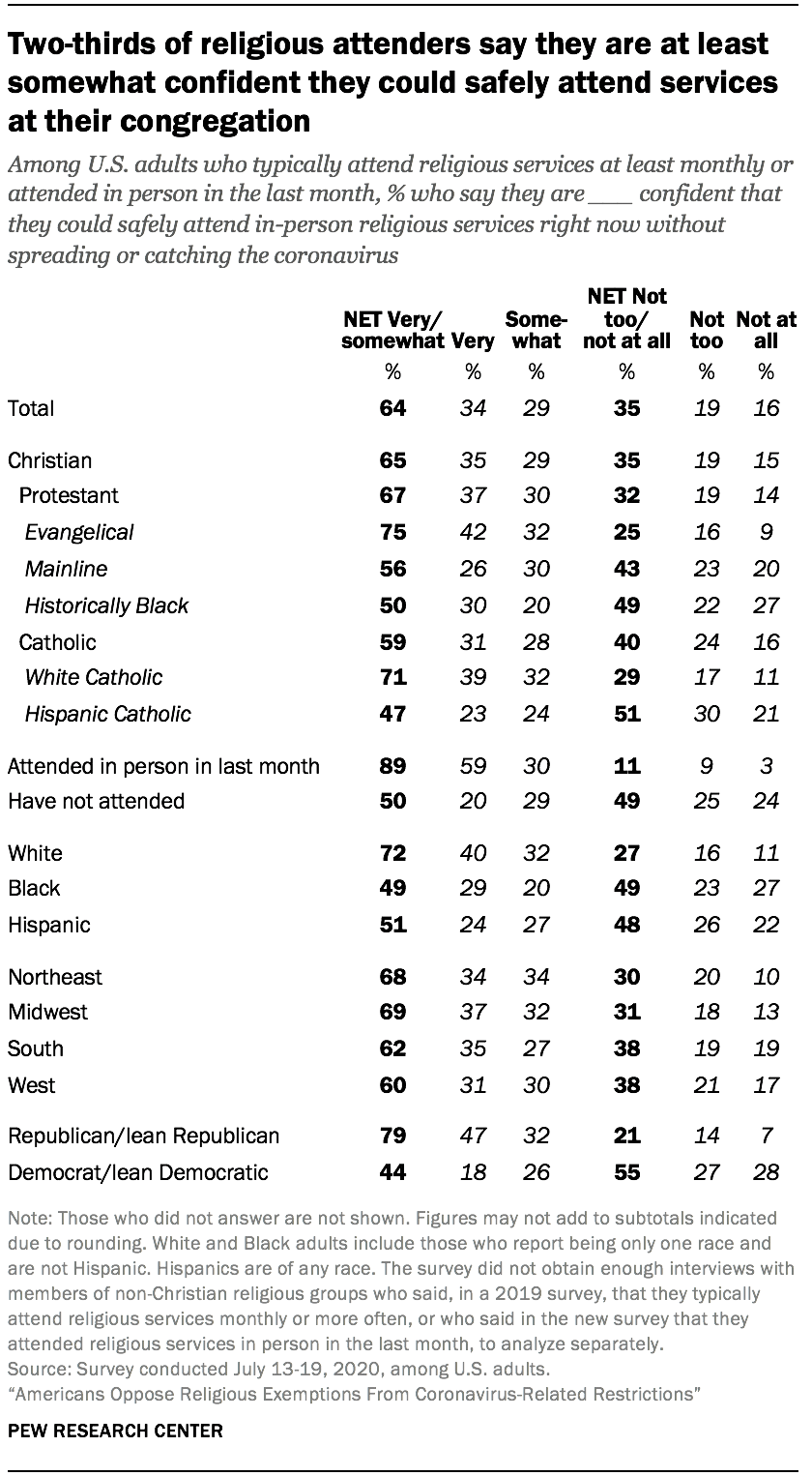
Overall, two-thirds of regular religious attenders are “very” or “somewhat” confident they could attend services safely without contracting or spreading the coronavirus. Levels of confidence are highest among evangelical Protestants (75%) and white Catholics (71%), and are lower among other Christian groups.
There also are broad racial and ethnic differences: White Americans have been less affected and are less worried about the effects of the pandemic than are Black and Hispanic Americans.
Not surprisingly, the vast majority of people who say they have attended religious services in person in the last month (89%) say they are confident they can do so without catching or spreading the virus. But even among those who have not attended in person recently, half say they are at least somewhat confident they could safely do so.
Little support for religious exemptions from social distancing requirements
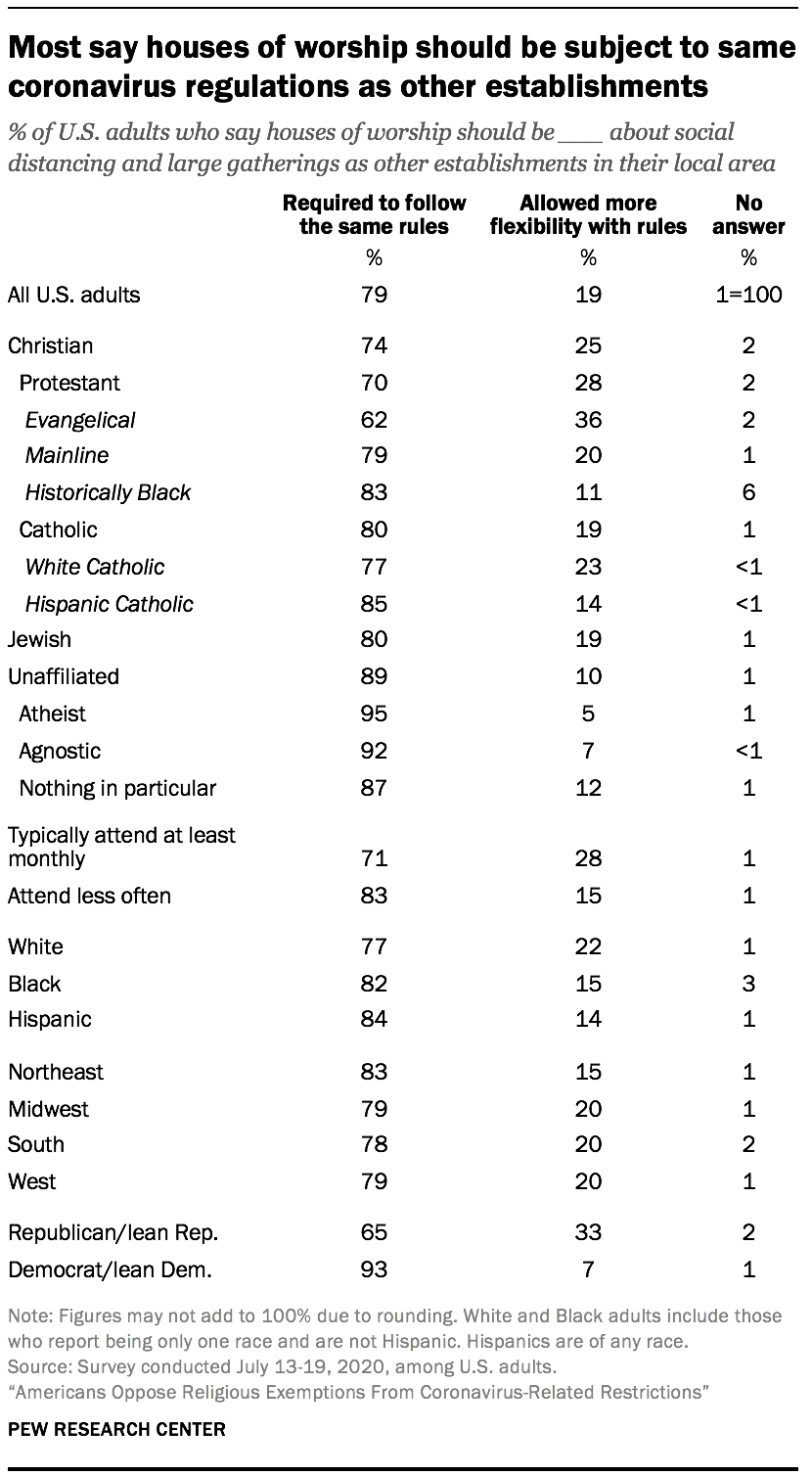
Majorities in all religious, demographic and political groups analyzed in the survey say houses of worship should be required to abide by the same social distancing guidelines and restrictions on large gatherings as other establishments in their local area.
Support for this view is higher among self-described atheists and agnostics and among people who typically attend religious services a few times a year or less than it is among religiously affiliated Americans and those who attend regularly. Still, majorities in all religious groups oppose religious exceptions to regulations designed to slow the spread of the outbreak.
Correction (Aug. 10, 2020): In the chart “Among regular worshippers, one-third say they have attended religious services in person in last month, nearly three-quarters have watched virtually,” the number for white Catholics who have attended religious services in person has been corrected, as has the text about that finding. The change was very small – 1 percentage point – and does not affect the report’s substantive findings.